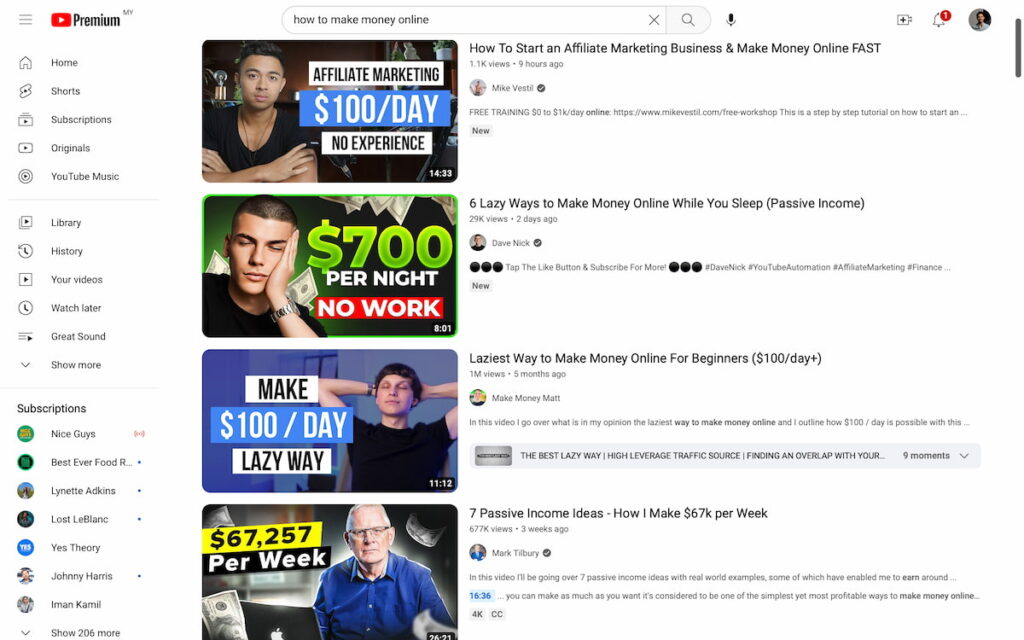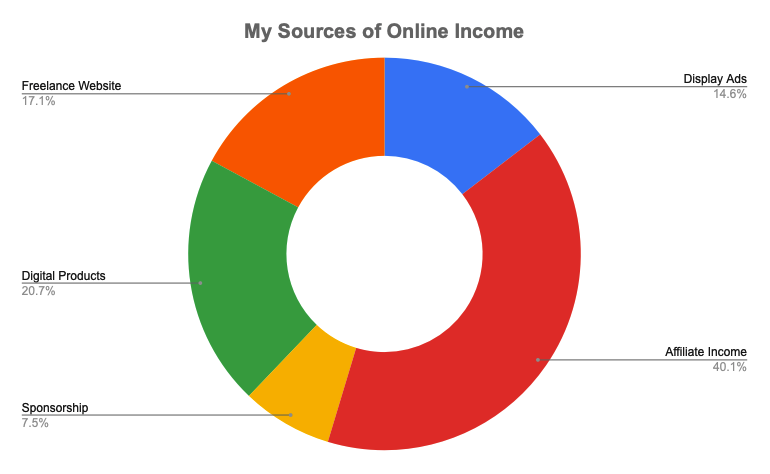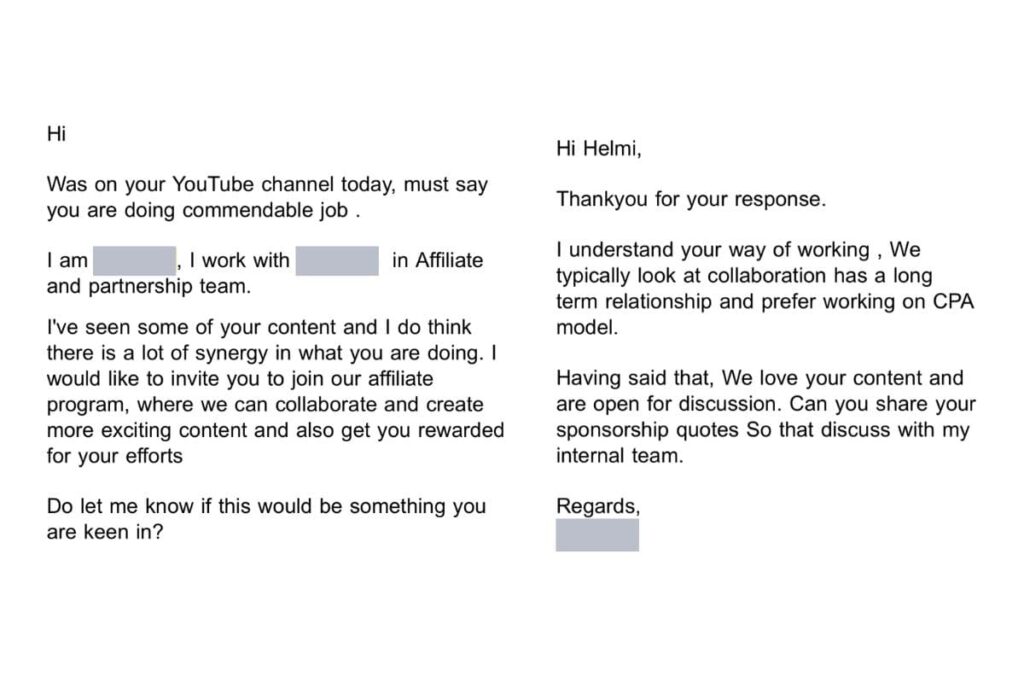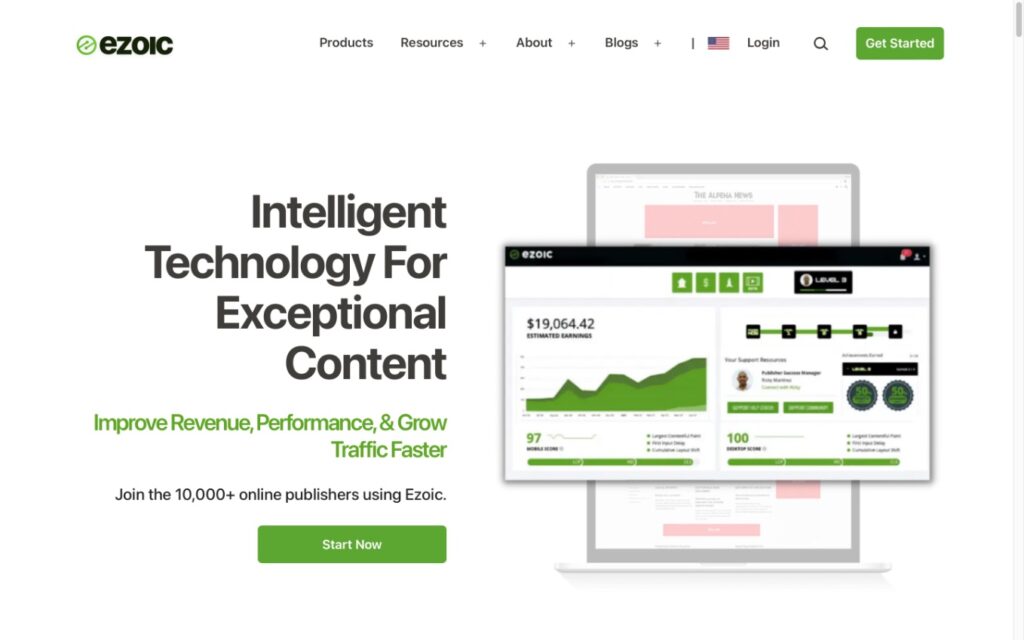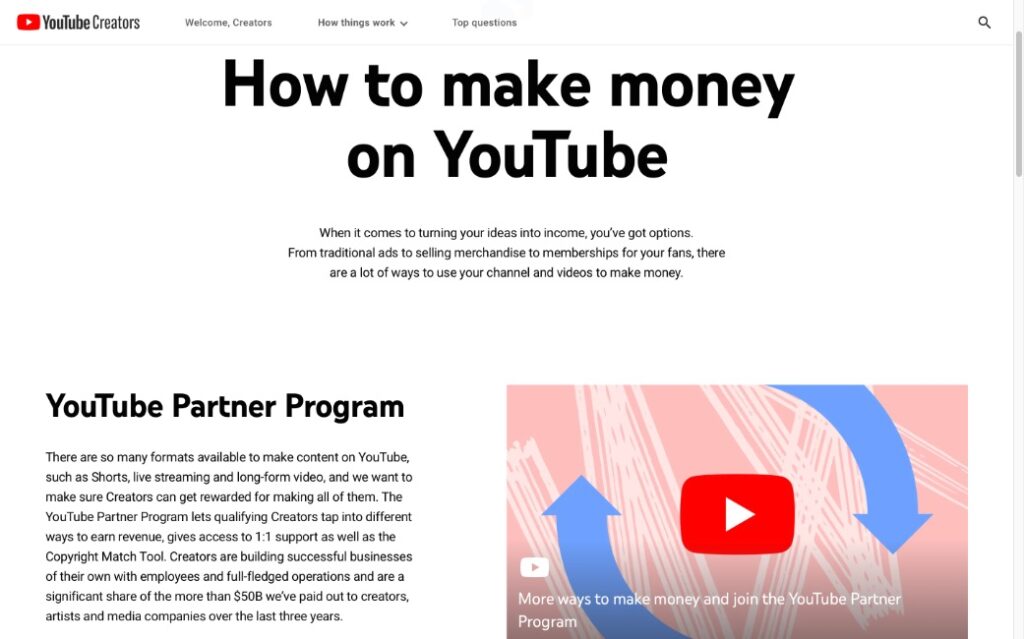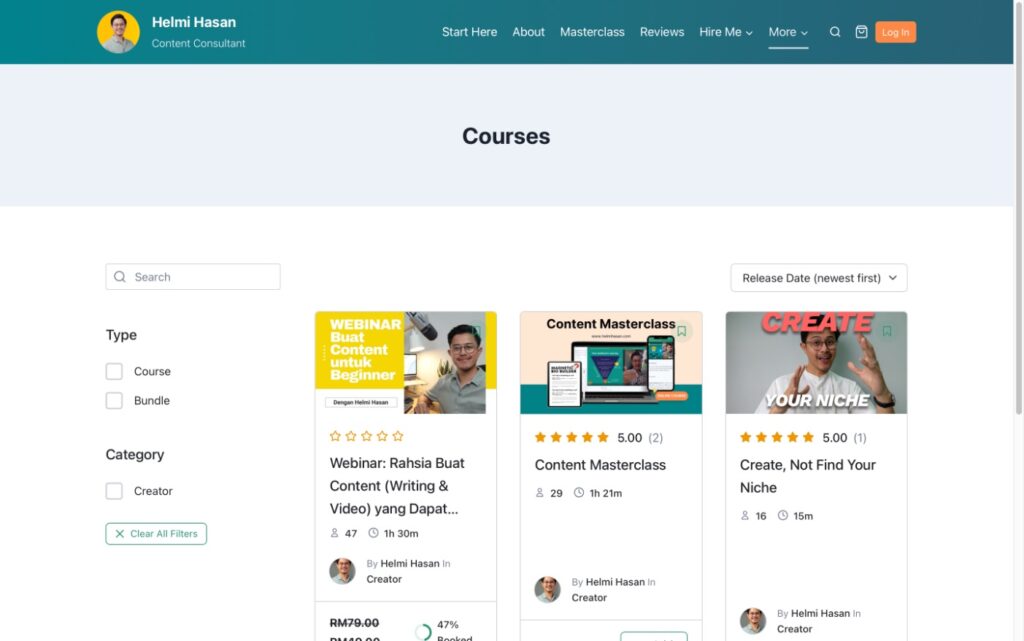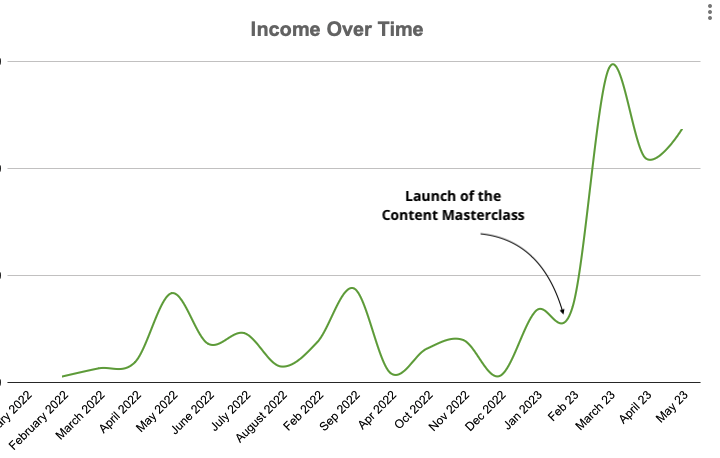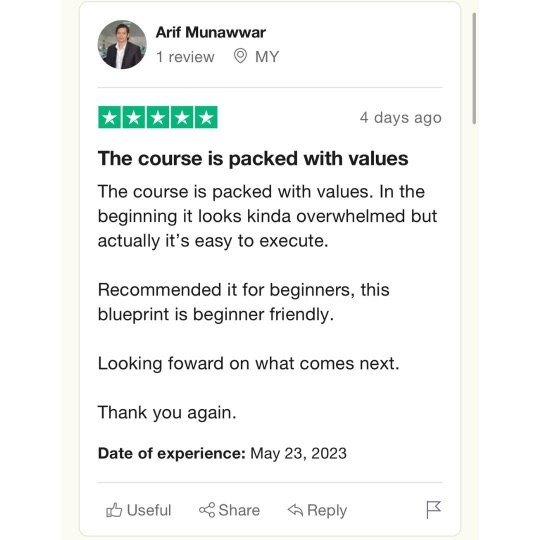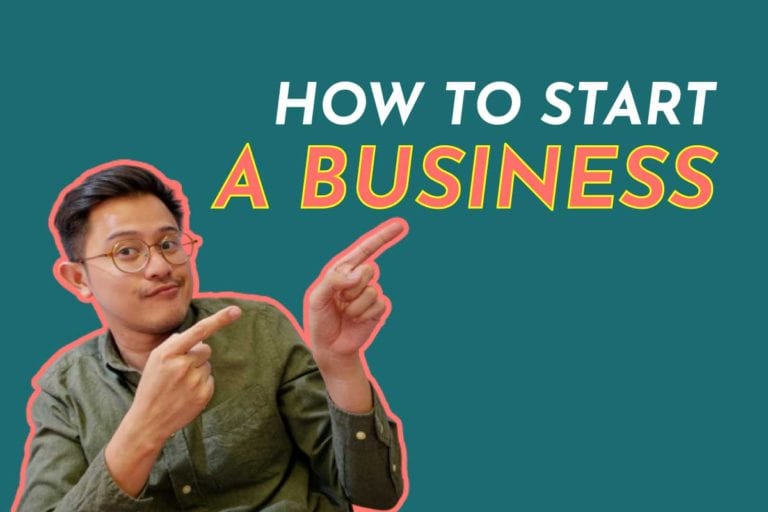The TRUTH About Making Money Online: My 5 Income Streams
Go into YouTube & search: “How to make money online” and see the results:
It looks like 80% of these videos are by a bunch of high-school kids teaching us how to make a fortune online without putting much effort.
Seriously?
But hold up, let’s put our skepticism aside for a moment & imagine:
If you can make money online as these videos on YouTube claim, let’s imagine what your life would be like:
- You can be a self-made entrepreneur
- You don’t have to fit into a job & someone else’s culture
- You can work anywhere & with whoever you want
- you can create your own lifestyle
So I get it, the allure to make money online is very strong.
So looking at these kids & comparing them with where I am in life, not going to lie, as a 35-year-old guy, I do feel like what the hell am I doing with my life?
If these YouTube kids claim they can do it, I’m pretty sure I can too.
So I went on an epic quest to seek this elusive ‘make money online’ dragon.
After several months of:
- experimenting
- hustling, and who’s kidding who:
- multiple failed half-assed projects
I’m happy to report that I currently found 5 online income streams.
Not too shabby.
But don’t listen to what these kids are saying on YouTube.
Most of them are oversimplifying the process to make it sound attractive to whatever it is that they’re selling.
So in this article and video, I’m going to share the TRUTH about each of my 5 online income streams, so you can learn from my mistakes & stop wasting time from trial & error.
So let’s get started.
A Little Backstory
I have 2 online brands. See below for the target audience & links to content:
Helmi Hasan
Niche: Digital Content Marketing
Audience: Businesses, founders & aspiring Content Creators. Perfect channel to promote SAAS, personal finance & productivity products.
Audience Channels:
Millennial Dad My
Niche: Malaysian Parenting
Audience: Expecting, new & existing parents in Malaysia. Perfect for advertising toys, baby gear & classes.
Audience Channels:
The income I’m reporting in this article is cumulative from both of my brands above, which I own & am currently running as a one-man media business (I have no staff, yet).
I’m sharing what works for me, my brand & my personality. Expect your outcome to be different.
Feel free to use my story & experience as an educated guide to save you time from trying to figure it out all by yourself.
My 5 Online Income Streams
I’ll start from the lowest to the highest slice of my online income pie & for each of these 5 incomes, I’ll share:
- What is it?
- Level of difficulty
- The pros & cons
- Key takeaway
- Tips for newbies
Let’s start with my 1st & lowest online income stream:
Brand Sponsorships (8% of Monthly Income)

What is a Brand Sponsorship?: When you collaborate with a brand to help promote or plug their products within your content in exchange for free products/services or money
Examples:
- Create dedicated content to explain & promote the product to your audience.
- The sponsor company might send you a sample for you to review.
Brand sponsorship is my lowest income category, contributing only 8% of my overall income.
Surprise surprise. You’d think an ‘Influencer’ will get a lot of money from big brand sponsorships.
Maybe some do.
But I didn’t want brand sponsorships to be my main revenue as I don’t want to be a sell-out.
What I mean by this, is that most sponsored content that brands want you to do typically doesn’t rank well organically.
If you create too much of sponsored content, your views & growth will suffer.
So I never reached out to any brands, and all of the brand sponsorships I got were from brands who found YouTube, TikTok, or blog & contacted me via email.
I have yet to do any outbound emails. At least, not yet. How to reach out to brands for collab could be a separate digital sales masterclass by itself.
Make sure you subscribe to my Creator newsletter & receive a free quickstart Creator starter guide:
Who’s it For? – Brand Sponsorships
Brands with some online following. But you don’t need many followers to get approached by brands.
In fact, I’ve secured a TikTok video sponsorship for my 2nd brand, Millennial Dad My when I only had around 1600 followers.
I’ve also gotten brand sponsorships on my YouTube channel when I only had around 2000+ subscribers too.
What I noticed is that brands approach me because they found out about one of my videos & liked my online persona & my unique style of how I explained things.
Here’s an example of an email I got that started a brand collab.
Notice that they approached me to do an affiliate deal, but I negotiated to get an affiliate + media package deal.
They liked my vibe online, so they’re willing to hear out my counteroffer.
That’s the benefit of having a personal brand.
Level of Difficulty – Brand Sponsorships
If the brand approached you, chances are they like your online personality.
So it’s pretty hard to disappoint them unless you screwed up really bad like you didn’t fulfill what was promised in your agreement.
I’d give brand sponsorship a difficulty rating of 2/5.
Pros & Cons of Brand Sponsorships
Pros
- You get to work with brands you love
- Sometimes, they’ll approach you!
- A strong personality draws in sponsors.
- If they like you, name your price.
- Once you have one, you’d attract more sponsorships.
- You’ll be more valuable to the sponsors if you have a clear niche & audience.
Cons
- Without a personality, you’ll be a commodity.
- Don’t let the brand tell you what content to create.
- Some brands who approach you will test if you’re desperate.
- Need to backup for your asking price.
- Need to make sure that the thing you’re promoting is relevant to your brand & style.
Advice for Newbies – Brand Sponsorships
- Personality is key. Brands want to work with you because they LIKE YOU.
- You can demand the highest pay on YouTube.
- TikTok has the lowest quality, cheap sponsors. You can start there but quickly move to YouTube ASAP.
- If you want to attract brands faster, create free content promoting their stuff for free first. Sooner or later, they or their competitors will reach out to you.
- You can learn how to incorporate personal branding & the strategies to have enough core content in my Content Masterclass.
Display Ads (15% of My Online Income)

What are Display Ads?: Advertisers want to place their ads on your digital content.
It’s kind of like a billboard. If you own a billboard & there are a lot of people who can view the billboard, you can rent out ad space to brands.
The more traffic you have (eyeballs to the billboard), the higher you can charge for placing that ad.
Now, your website or YouTube channel is kinda like a digital billboard.
There are 2 ways to place ads on your digital assets:
Manual Ad Placements
Direct deal with Advertisers, where they can place their ad on your blog, email newsletter, online course, or digital products.
The advertisers will give you the ad (sometimes called a graphical asset). You don’t have to do any creative work.
You then manually embed or place that ad at the agreed placement.
Automatic Ad Placements
Usually, when you’re starting out, brands won’t want to deal with you directly.
Also, keeping track of all these ads over time can be extremely tedious. So a better way to approach monetizing with display ads is by using an ad network or broker.
- If you have a website, sign up with an ad broker like Ezoic. Where they can automatically insert ads throughout your site.
- YouTube has the YouTube Partner program. They handle the ads & split the profit with you.
Display ads contribute 15% to my online income.
Back when I started blogging, I registered my blog with an ad broker called Ezoic.
Instead of you pitching to advertisers to rent your ad space individually, Ezoic will automatically match your website content to relevant Advertisers.
Once Ezoic is integrated with your site, they’ll automatically place relevant ads throughout your website & split the advertising revenue.
You can check out how much I earned when I 1st started with Ezoic here:
I stopped my partnership with Ezoic because, at some point, I shifted my focus from SEO writing to video & Twitter.
I didn’t feel like the revenue I was earning from display ads on my blog justified the ads throughout my content, which I think distracts my readers.
The only ad revenue I make now is with the YouTube Partner Program, and it contributes about 15% of my online income.
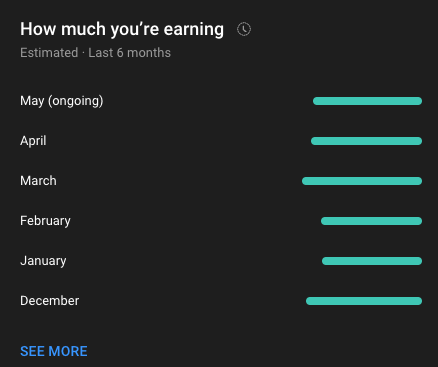
This is as passive as online income can get.
Who’s Display Ads for?
Display ads with ad brokers only work if you own a website (that means you bought a domain name & hosting package).
Most ad brokers won’t accept your application if you didn’t buy a domain, for example:
- yourname.wix.com – ❌
- yourname.wordpress.com – ❌
- yourname.squarespace.com – ❌
It needs to be yourname.com or yourname.io. In other words, you can’t have Wix or WordPress or equivalent in the middle of your URL.
Can you make money from display ads on social media? No. There is no split in revenue from any other social media platforms. Not Facebook, Instagram, Pinterest, or TikTok.
Your only other option besides having a blog is YouTube.
But there are requirements to get you into the YouTube Partner Program.
Level of Difficulty – Display Ads
There’s really nothing to it besides meeting the minimum requirement to be a partner with Ezoic or YouTube Partner program.
I’d give this a difficulty rating of 1/5.
The Pros & Cons of Display Ads
Pros
- Passive Income.
- No creative work on your side.
Cons
- Earnings are low if you don’t have much traffic.
- Only works if you own a website or are in the YouTube Partner program.
- Ads could annoy your reader/viewer.
- There could be your competitor’s ad on your content.
Key Takeaway – Display Ads
- Ad brokers are only for people who own a website (domain name & hosting).
- No social media platform shares ad revenue with you.
- YouTube shares ad revenue but you need to be eligible for the YouTube Partner Program.
- Manual ad placement is harder to do for a beginner. So focus on building an audience first.
Advice for Newbies
- If you’re into writing, register for a website & start blogging. I personally use Hostinger. Then, register an account with Ezoic to automatically place ads throughout your website.
- If writing is not your thing & you’re more into making videos, meet the minimum requirement for the YouTube Partner Program & start making money from your videos.
Most new Creators don’t have enough regular core content to be taken seriously by brands. So if you need to define your branding & content strategy, I highly recommend checking out my Content Masterclass.
Freelance Work (17% of My Online Income)

What is Freelancing? – This is when you package up your skills, and charge people to help them solve a specific problem.
Popular Examples:
- Website development – help business set up their website.
- Social media package – not all businesses have a marketing team to handle this.
- Programmer – for businesses who want to start an online business.
- Babysitter – underrated & a babysitter with qualifications is in super high demand
- Copywriter
- Videographer/editor
- Programmer/developer
Freelancing is a new stream of revenue for me that contributes a respectable 17% of my online income.
How I got started:
I was sharing my journey as a Digital Content Consultant on Twitter & the projects that I’m working on. Here they are:
Then, a few people who resonated with my content DM-ed me to ask if I can solve their similar problems.
After a few back and forth, they made the booking payment.
Currently, I have 3 WordPress website projects to deliver (still ongoing as of this writing).
Who’s Freelancing for?
- Anyone who has an in-demand skill.
- Creators who are in need to make quick cash while waiting for their organic content to take off.
- Anyone who wants to earn extra money, even if you currently have a full-time job.
- People who plan to go into an industry full-time can test the waters by freelancing first.
Level of Difficulty – Freelancing
People always portray freelancing as easy.
But the truth is, freelancing means you have to deal with a lot more than the execution of the service, you’d have to do the:
- marketing
- sales
- finances & invoicing
- customer support
- execution of the service (people only talk about this)
- extra services (upsells)
So I’d give freelancing a difficulty rating of 4 out of 5.
The Pros & Cons of Freelancing
Note: Freelancing is such a huge topic & I can’t speak for everybody.
My analysis is skewed toward web development, which is the service that I’m currently selling.
Pros
- You can earn extra money or replace your main source of income.
- You generally get to pick who you work with.
- You can set your own hours & price.
- Freedom to work wherever you want (digital nomad).
- Fulfilling as you get to pick what service you want to offer.
Cons
- You literally have to do everything from sales, marketing, admin, finance & execution.
- Can be tough & overwhelming to manage your time.
- There will be times when you have to burn the midnight oil to meet project deadlines.
- You don’t have benefits like a full-time employee.
- Need to handle your own finance & pipeline of future clients & work.
Key Takeaway – Freelancing
- Don’t quit your job to go cold turkey into freelancing. Start on the side first.
- Freelancing is incredibly rewarding because you can pick what you’re working on.
- You need to learn to manage your time & money extremely well.
- You need to do SALES & MARKETING for your personal brand (underrated).
Advice for Newbies – Freelancing
Depending on the type of work, generally, if the job does not require much brainpower, it will be physically tiring (i.e. food delivery).
On the flip side, if it doesn’t require much physical, it’ll be mentally exhausting (i.e. programming or web development).
For beginners, I’d recommend you freelance in a skill that you learn from work.
If you’re a copywriter at a company, offer copywriting skills online.
It’ll make your transition into freelancing A LOT easier.
Also, personal branding is super important. That’s how you decommoditize yourself.
Without a strong personal brand, you will be competing with people from Upwork or Fiverr (mostly from Pakistan or India) that will do the job for pennies & collapse the market price.
I don’t recommend going on Fiverr or Upwork. Learn all you need to personal branding & creating content to promote yourself in the Content Masterclass.
Digital Products (21% of My Online Income)
What is a Digital Product? – A product that exist online. You can charge people for each download or per access.
Popular examples are:
- An ebook
- a webinar
- a template (Notion, Canva, or WordPress)
- a software (an app)
- a plugin (for WordPress or video editing software)
- a preset filter for video/photo editors
- or an online course
The sales of my digital products (online course in my case) contribute to 21% of my online income.
Examples of My Digital Products
- Content Masterclass – online course
- Webinar – buat content untuk beginner
I put my heart & soul into creating these digital products & I’m incredibly grateful to get positive reviews for both my webinar & online course.
Check out the online mentions from my students below.
Content Webinar Review
Content Masterclass Review
The cool thing is I feel a great sense of purpose when I get these sorts of responses.
I learned from this experience that teaching people is a thing I genuinely enjoy.
Who Can Sell Digital Products & What to Sell?
Literally anyone.
Everyone has some skills that can be monetized.
You don’t have to be perfect to start teaching people stuff, just teach people who are just a couple of steps behind you.
Here are some examples to get your ideas running:
- If you’re a photographer, you can sell Photoshop templates.
- If you’re a videographer, you can sell video editing LUTS.
- If you’re a writer, you can sell an ebook about a topic of your choice.
- If you’re a parent, you can package up your info as an ebook or online course.
- If you’re a chef, you can open up an online webinar class or sell an ebook of your recipes.
- If you’re a property agent, you can sell checklists for 1st-time homeowners.
- If you’re an insurance agent, you can sell personal finance Google sheet templates.
The internet has made this opportunity literally attainable to anyone.
Level of Difficulty for Selling Digital Products
The level of difficulty will depend on what you’re selling & to who. Here’s my take:
- To create a digital template: 2/5.
- To create a webinar: 4/5 the first time because you need to create the slides, 2nd time & beyond, I’d put the level of difficulty at 2/5.
- To create an online course: 5/5. I do not recommend beginners starting with an online video course. It’s a LOT OF WORK.
The Pros & Cons of Digital Products
Pros
- A great way to sell your expertise or idea to your online followers.
- Create once & sell for years.
- You have full control of your digital products if you sell them on your own website.
Cons
- Creating a digital product can be resource intensive.
- You need to figure out how to accept payments & manage orders.
- Digital products won’t sell themselves. A strong personal brand will help A LOT.
- Setting up & learning how to sell on your website will take a LOT of time & technicalities but worth it in the long run.
Key Takeaway for Selling Digital Products
- Hard to produce = low competition
- Easy to produce = high competition
- The best place to sell your digital products is on your website.
- Once the product is completed, you still need to promote your products constantly.
- Having a strong personal brand will help you out A LOT.
Advice for Newbies to Sell Digital Products
- It’s hard to sell anything if you don’t have a personal brand. So it’s a good idea to build an audience first before you start selling anything.
- Validate that there is demand for the product first before you waste time creating your digital product.
- Start with cheap templates for around $5. Those are the easiest to produce & sell to validate your big idea.
- Selling webinars is not a good idea for a beginner because nobody knows you. Nobody’ll show up.
- Selling on your website is the best. But for a beginner, you can start selling on Gumroad or Payhip.
Affiliate Income (40% of My Online Income)
What is Affiliate Marketing?: Is when you promote other people’s product or serivice online, and when someone buys through your link, you’ll earn an affiliate commission.
Examples:
- Shopee or Lazada affiliate for people in Southeast Asia.
- Amazon Affiliate.
- Affiliate networks (Involve Asia, Partnerize & Impact).
I’m surprised that affiliate marketing is my largest contribution at a whopping 40% of my online income.
Look at me, Mr. Influencer 😎
Who’s Affiliate Marketing for?
Anyone can start affiliate marketing.
In fact, it’s the one I recommend to most people if they never made money online.
Level of Difficulty for Affiliate Marketing
I’d say it’s easy to do at a difficulty level of 2/5. But to consistently perform as an affiliate marketer will take some talent & loads of practice.
Affiliate Marketing Pros & Cons
Pros
- Passive income.
- If you build a solid personal brand, your audience will want to click on your link & support you.
Cons
- You need to create content consistently.
- Your content needs to be good.
- Harder to do if you’re a nameless brand.
Key Takeaway
- Some niches pay higher than others. Usually, stuff that is high stakes & hard to sell. For example, Finance.
Advice for Newbies
- The easiest way to start is by promoting cheap products from Shopee or Amazon.
- Start by reviewing products you bought & genuinely love.
- Register as a Partner on an affiliate network like Involve Asia. Step-by-step guide here.
What Did I Learn from Making Money Online?
Let’s look back at my online income pie chart:
| Income Type | Percentage % | Difficulty |
| Brand Sponsorship | 8% | 2/5 |
| Display Ads | 15% | 1/5 |
| Freelance Work | 17% | 4/5 |
| Digital Products | 21% | 5/5 |
| Affiliate Income | 40% | 2/5 |
From the chart above, affiliate income is the optimum method to scale my online business:
- Maximum earnings
- Lowest effort & difficulty
How Long Does it Take to Make Money Online?
If you know what you’re doing, you can monetize really fast.
However, if you’re reading this article, I assume you’re a new Creator & would want to know a realistic timeline to start monetizing.
I’ll share with you my timeline below:
- In Feb 2022, I started monetizing my blog & YouTube channel with ads. I still had a full-time job at this time.
- I’ve been trying to grow my online presence ever since, but work, getting married & having a child really took a toll on my priorities, focus & free time.
- In Feb 2023, I launched my first digital product: the Content Masterclass in Feb 2023 & my income took off.
- The compounding effect of the launch of my digital product opened up other revenue streams such as freelance work, which is my 3rd largest income source.
This is my journey under my unique circumstances. What I can say is that you must try as many ways to make money as possible to figure out which one you like & can stick with your personality & goals.
Which Online Income I Enjoyed the Most & Why?
I like that I have a variety of ways to make money online & am not totally relying on just one.
But out of all these income streams, I enjoy selling digital products the most.
What I discovered when I started selling my online course: the ‘Content Masterclass‘ & is that I thoroughly enjoy teaching people.
There’s just something about it when I teach or coach people,
- See their eyes light up
- See them get excited about their own project
- Make them see that there’s hope
It brings a great deal of satisfaction & fulfillment me, beyond the monetary gains.
Check out all of my reviews here.
What Will I Focus on in the Next?
Since I like training so much, I want to focus on that. So I’ll concentrate my focus on:
- Selling my online course
- Doing more webinars
- Try to do small group physical training
- Private coaching
Making Money Online My Honest Thoughts
Whichever path you choose to make money online, having a personal brand will help you sell A LOT EASIER.
The internet has made it possible for anyone to turn their dreams into reality.
- You can own your own digital real estate (website).
- All you need to start a video channel is your smartphone.
- Selling digital products is easy with Gumroad & Payhip.
- Accepting online payment is also easy with Stripe, Toyyibpay & Atome.
Seriously, now is the best time to make money online.
Learn to Grow & Monetize Online Systematically
Learn to Grow & Monetize Your Personal Influence
- Gain followers & influence online
- Earn income online, and
- Materialize your ideal life,
You can achieve all the above with the Content Masterclass:
I teach all I know to get me to this point to grow your brand & monetize online through magnetic content. Here are some student testimonials:
Check it out here:

